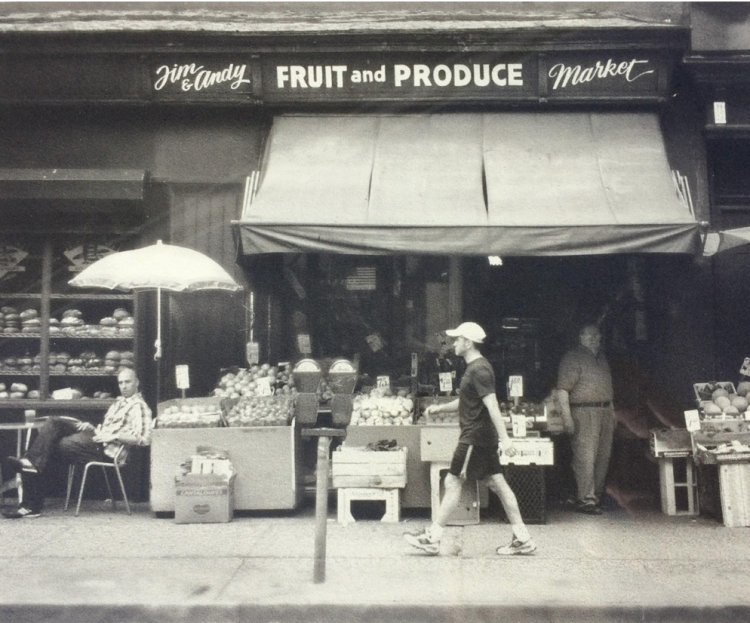How Jimmy the Peddler Transformed Court Street

In 1939, at 13 years old, Jimmy Cincotta would wake up at around three in the morning to collect a day's worth of fresh fruit and vegetables from the produce market on West Street, Manhattan. Living up to his nickname, “Jimmy the Peddler,” he would return to Brooklyn for a few hours of sleep before hitting the streets with his horse until seven pm, often crossing the Brooklyn Bridge on his route. He would repeat this cycle seven days a week, only ceasing if the temperature dropped below 30 degrees, too cold for the horses. If it were up to him, Jimmy would continue even on the coldest New York mornings.
Image Credit: Brian ChabrunnSince 1970, Jimmy’s brick and mortar store, Jim and Andy’s at 208 Court Street, stood as a permanent fixture to the neighborhood. Co-run with his son, Carmine Cincotta, the no-frills store supplied Manhattan’s Michelin Star restaurants with top-notch produce, yet supplied Cobble Hill with much more. Handwritten signs, photos of Jimmy’s favorite horse Dolly, the cat Monte (who famously had six toes), and the abundance of character shared between Jimmy and Carmine rendered the store a shared community.
As Jennifer Lee of the New York Times said, “This was a pre-Whole Foods approach.”
Image Credit: Brian ChabrunnJimmy allowed customers to hold hefty tabs, had an abundance of liquor readily available throughout the holiday seasons, and threw parties that the neighborhood looked forward to each year.
“His sociability was such that he made good friends out of his customers and a social circle was built up around him. [He] had the attraction of personality and product,” says Carmine Cincotta.
The same can be said for Carmine, who was often spotted in the back of the store working on his New York Times crossword puzzles. The regulars knew to stop by on Monday morning when he was working on the hardest day’s puzzle (Sunday) to lend their help. It became a community event.
“I have a bunch that come in and do it then. There are guys who are good for certain things, you know?" Said Carmine in Family Matters on Court Street.
In 2009, Jimmy The Peddler passed away, but the store remained. In a neighborhood where “bars have become bodegas, which in turn have become restaurants and real estate offices. The store, with its brown sign and simple facade of fruit and vegetables piled on crates, has remained a constant,” Ben Gibberd, a New York Times journalist, said.
Image Credit: Brian ChabrunnEven after his passing, the King of Produce, as the New Yorker referred to him, found himself winning neighborhood sports brackets with the help of locals determined to keep his memory alive. Three years later, the store shut its doors; however, the vitality of Jim and Andy’s remains present.
Today, in all its madness, New York City exists in a world where ease and accessibility is key to business. Brick and mortar stores have been replaced by Whole Foods, PeaPod, and Fresh Direct. It is more apparent than ever that convenience outweighs personality.
“You always have to be nice to your customers but they have to come through the door first. The door has been replaced by smartphones,” says Cincotta when asked about the importance of personal charm in today’s atmosphere. This reality, though sad, is true.
This change started to become visible in the early 2000s. As the pace of life increased in New York City, and the digital world began to take off, the shift in attitude was overwhelmingly towards convenience. Even then, “the younger generations went to different stores. I know that many appreciated the store, but not enough,” says Jimmy’s Daughter, Nancy Cincotta.
Today, the pace of life has not slowed down, and neither has the search for convenience wherever it may be found.
If you go to 208 Court Street today, you will see a much different street, one that has been transformed by the abundance of young New Yorker’s trickling out of the popular neighborhood bar that now stands in the store's place. Still, the original facade remains, a hand-painted sign reading “Jim and Andy’s Fruit and Produce Market,” standing as a testament to the lasting impact that the store, and Jimmy, had on the neighborhood. Today, New York has become so fast-paced, digital, and rooted in convenience that it seems impossible, even as a New Yorker myself, for people to take the time to appreciate specialty stores.
Though it is worth noting the sacrifice that is present. We are missing the importance of personal relationships in specialty stores; one that brings together members of a community as something more than mere neighbors.
As Carmine says, “It wasn’t the store that was so special; it was the neighborhood that was special. Any community gets the types of businesses it deserves.”
Perhaps it’s time we put down the smartphones for a few minutes, slow things down, and recreate communities that have the ability to render such an amazing camaraderie between a store and its customers. We can all learn a little something from the charm of Jim and Andy’s.










